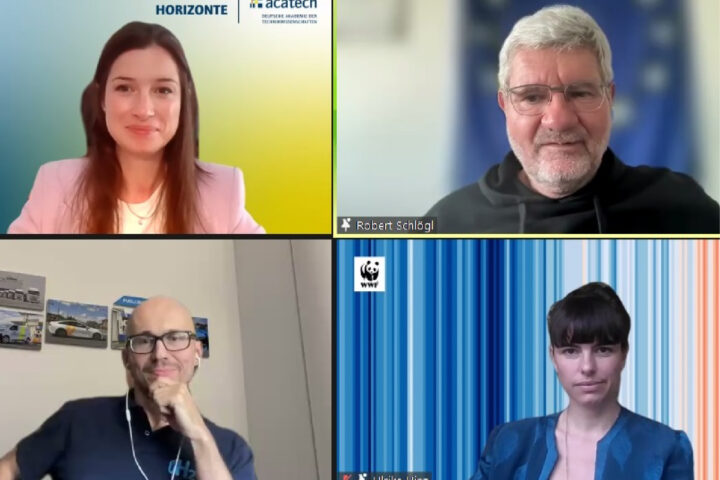acatech HORIZONS: Hydrogen
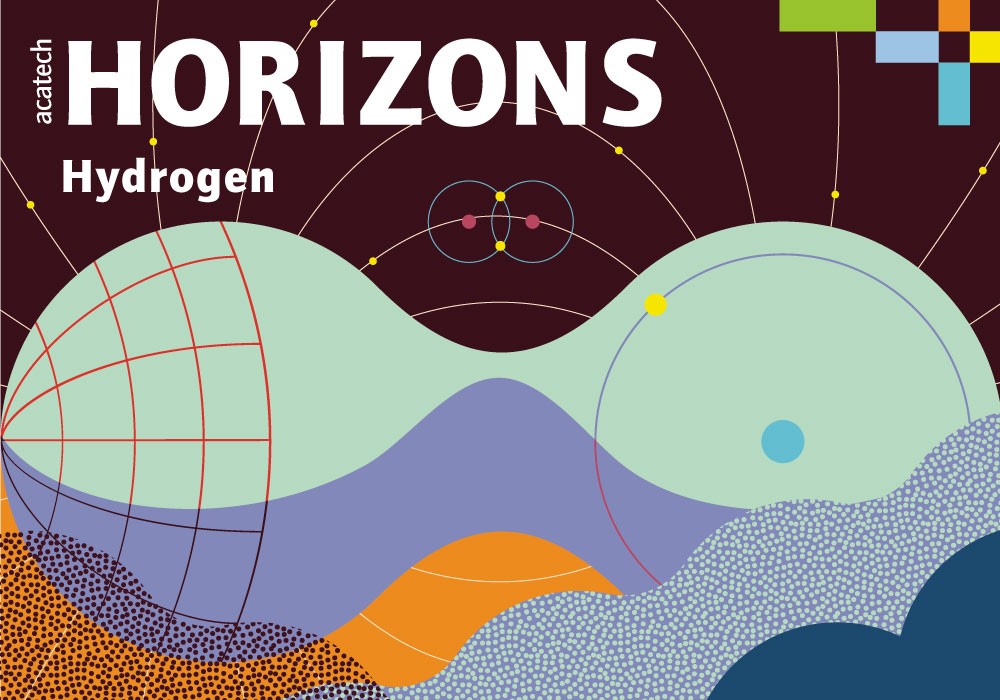
© acatech/Joseph & Sebastian
You may still vaguely remember hydrogen from your first chemistry lessons. If you burn it, energy is released. Its advantage is that this releases only water, not environmentally harmful gases. If produced in a climate-friendly way, it can help us turn our backs on fossil fuels such as coal and natural gas once and for all and finally make industry, transport and energy supply sustainable.
But how does this work and what technologies are already available? Where will the hydrogen come from? What is conceivable in the future and what still needs to happen? If this has piqued your curiosity and you’ve been on the lookout for a fact-based yet easy-to-understand overview of hydrogen for a while then you’re in the right place!
HORIZONS is also on LinkedIn. Follow us for “science in snacks”.
The acatech HORIZONS Podcast

“Late Night Tech” is a podcast for everyone who is up for science, technology and community insiders. Christina Müller-Markus and Dr. Sandra Fendl from the acatech HORIZONS team talk with well-known experts about current topics. A podcast from acatech, the National Academy of Science and Engineering.
By the way…
In the HORIZONTE logbuch you will find answers to some of the questions acatech HORIZONS hydrogen leaves unanswered.
What is hydrogen?
Welcome to the fascinating world of hydrogen. Why is everyone talking about it? Does it have anything at all to do with me as an ordinary citizen? What potential does hydrogen have for the environment and the climate?
Do you have any idea where all the hype about hydrogen is coming from? Scientists and politicians from all over the world have been racking their brains about it lately, the media are reporting on it, and industry wants to produce it and put it to use as quickly as possible. Yet the element hydrogen has been around for a very long time and is even older than the history of humanity! Hydrogen is being hotly debated today and ever more countries are considering their own hydrogen strategies, because it will play a very significant role in our future. But it’s not that simple, we’re only at the beginning and many issues remain to be clarified. The following illustration shows what we mean when we talk about hydrogen:
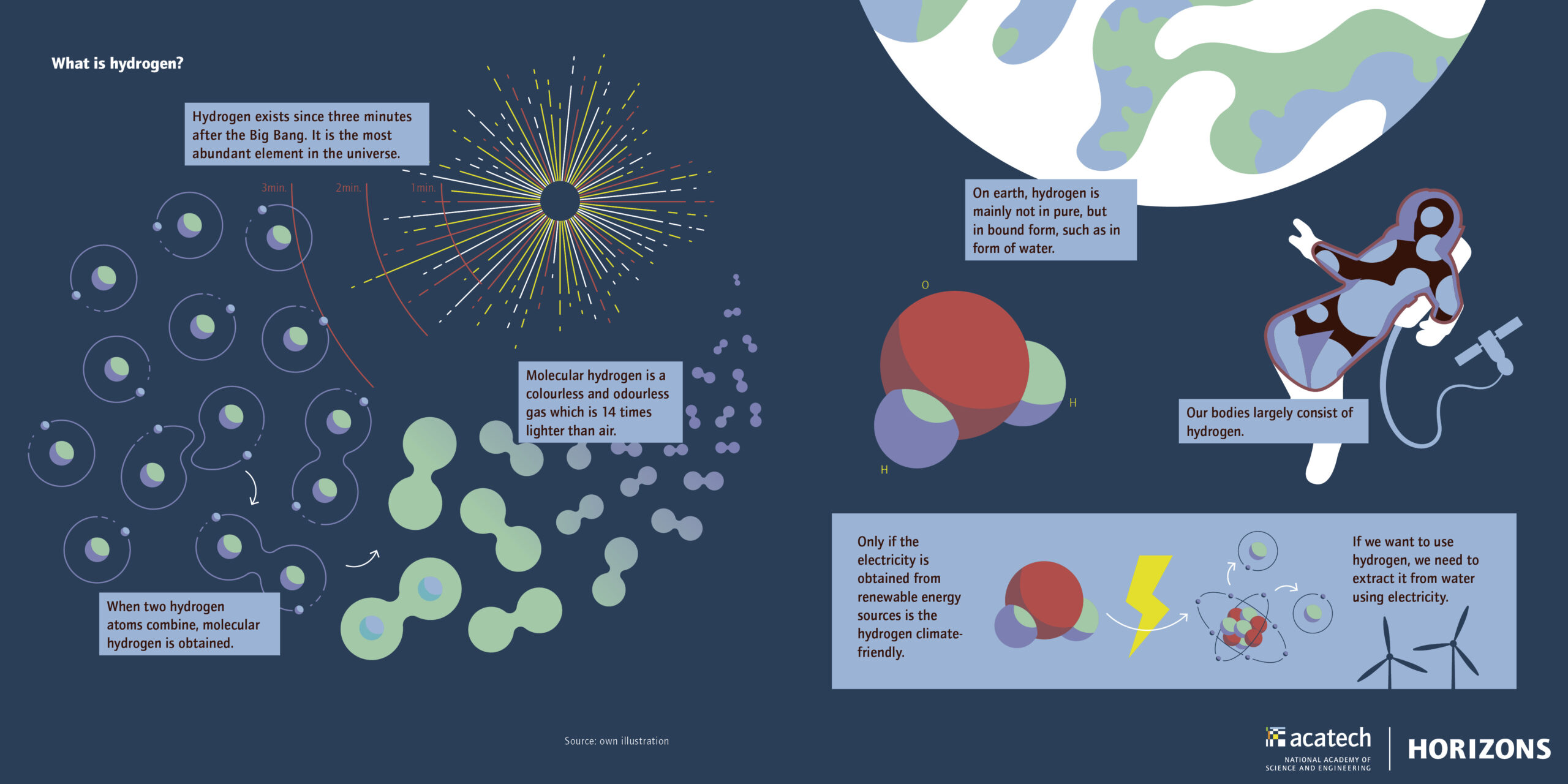
What’s already possible today? Where do we want to get to?
Whether as raw material for industry, as an energy storage medium or in transport applications, we can’t get by without climate-friendly hydrogen. What’s technically possible today? What are the obstacles and where do we want to get to?
The energy transition is actually not a difficult task. We’re just making life difficult for ourselves because we want to dot every “i” and cross every “t”. But we can’t go on researching until we understand everything; we didn’t start with the iPhone X when it came to smartphones either. We just have to get started.
Prof. Dr. Robert Schlögl, Präsident Alexander von Humboldt-Foundation
Hydrogen in industry
In industry hydrogen is used as a raw material, for instance to produce steel, cement, fertilisers for agriculture, plastics, or adhesives for electrical appliances. Industry also uses hydrogen to generate process heat, for example, for melting metals or plastics. The snag is that grey hydrogen results in the release of CO2, which is harmful to the climate. If we want to achieve climate targets, we can’t get by without climate-friendly hydrogen, which leaves no carbon Footprint.This will entail entirely restructuring a large part of our industry, which is still dependent on fossil fuels such as coal, natural gas or oil.
The steel sector, which still largely uses coal and, therefore, has particularly great leverage, has recognised the potential of climate-friendly hydrogen and is working flat out to completely transform its production model and make Europe fit for a green future. The following illustrations provide an overview.
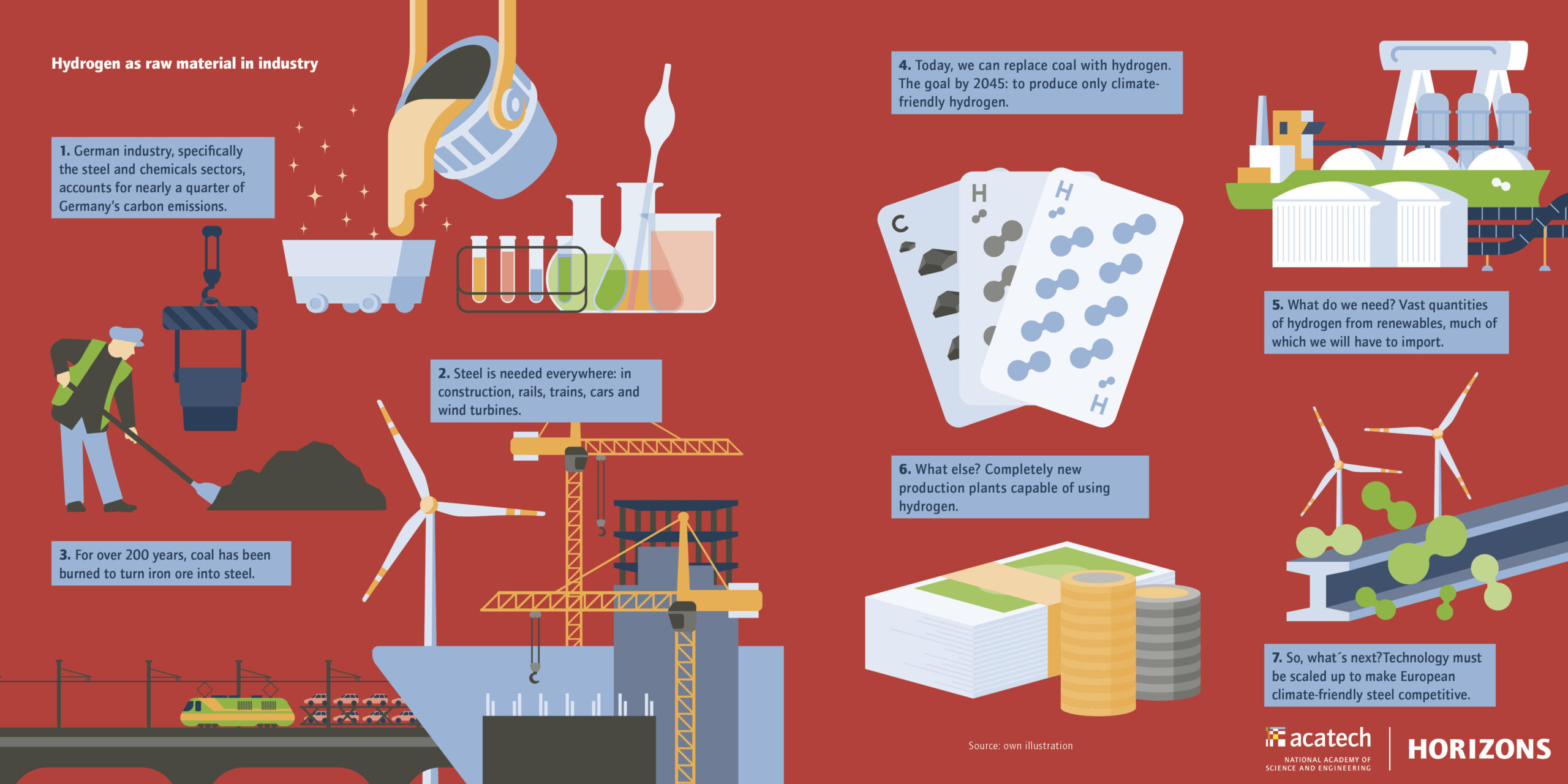
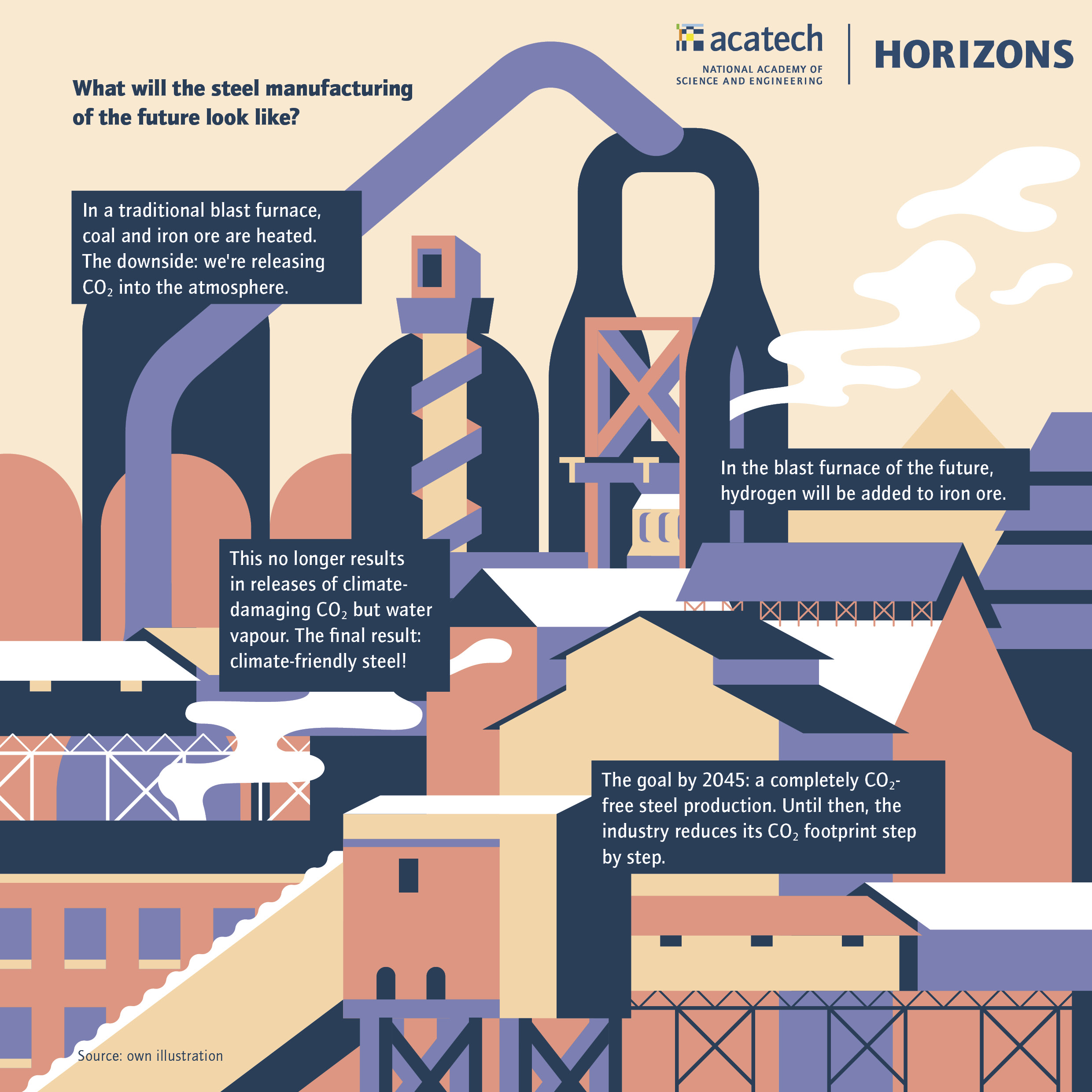
Oil and gas must stay in the ground! However, that will prove difficult while there’s still a lot of money to be made extracting them. So, the faster we get going, the faster hydrogen will become competitive and fossil fuels less profitable.
Prof. Dr. Christoph M. Schmidt, Präsident RWI Leibniz-Institut for Economic Research
Storing and transporting energy with hydrogen
Storing green electricity in batteries only works to a certain extend. If we want to achieve the climate targets and completely transform all sectors, i.e., industry, transport, or heating, and make them climate-friendly, we will need huge numbers of very large batteries using many different raw materials from all over the world. This would be unaffordable and would have an impact on the environment. This is where hydrogen comes in. We can use it to temporarily store electricity, transport it and convert it back into electricity. Hydrogen can be produced anywhere in the world and makes us less dependent on a few regions with fossile fuels.
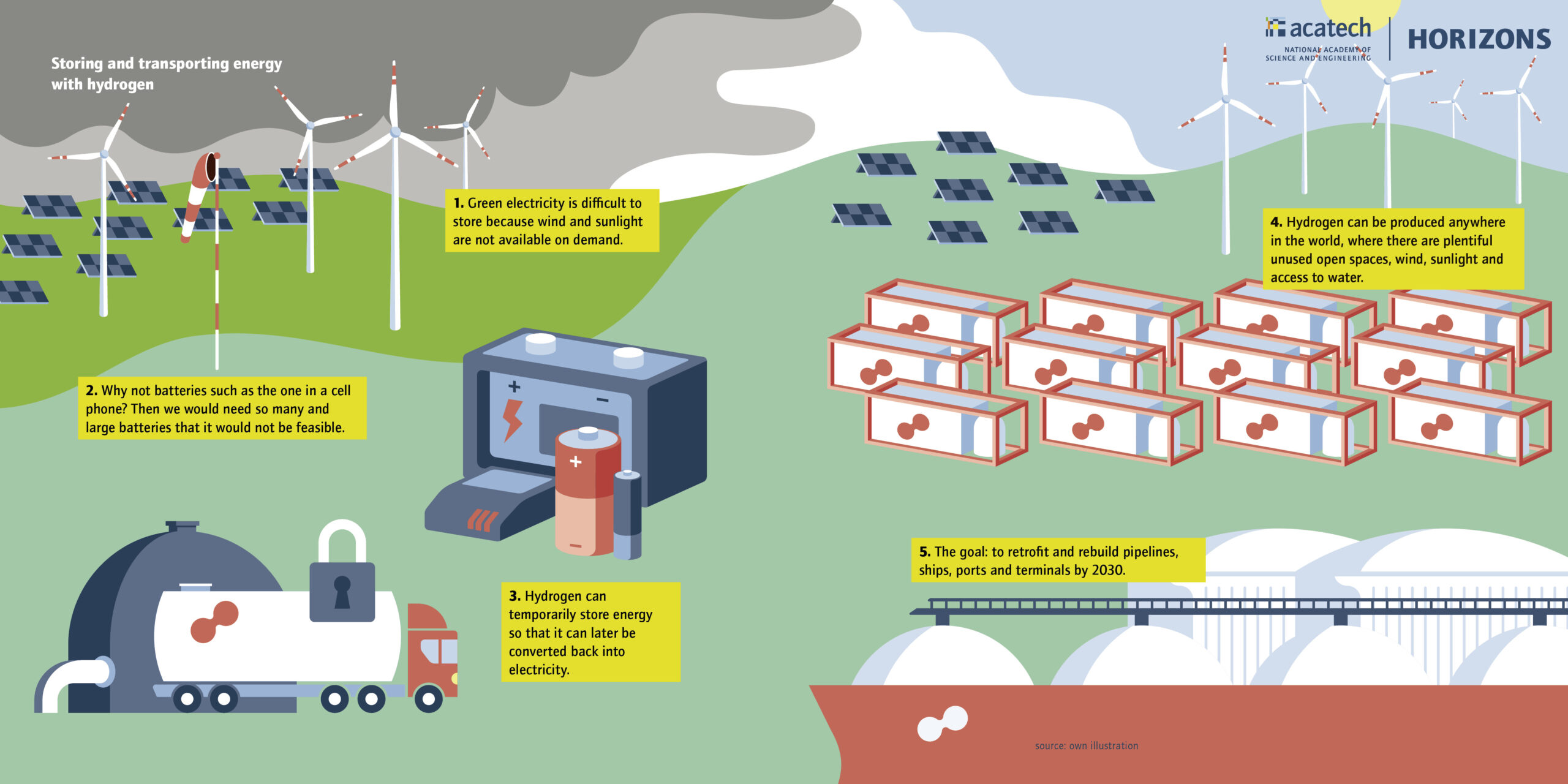
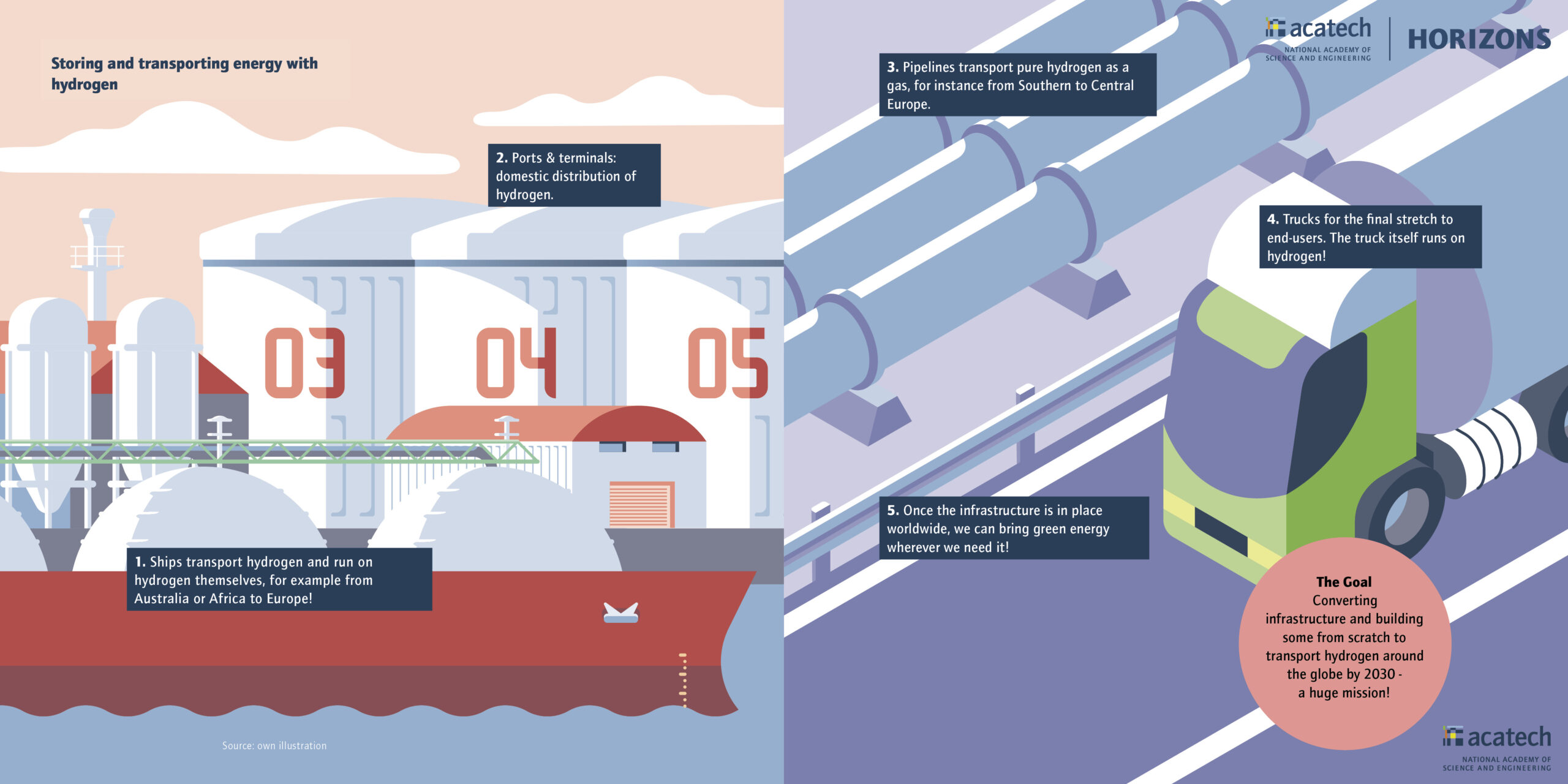
Hydrogen to feed the world
For millennia, humans have been fertilising fields with manure or slurry to help crops grow better. We still need to fertilise agricultural soils to feed the world’s growing population but manure and slurry are not enough nowadays, so we manufacture large quantities of synthetic fertilisers. The starting point for fertiliser manufacture is ammonia, a nitrogen compound of hydrogen and elemental nitrogen. Between the 20th century and now, we have mainly been manufacturing ammonia using hydrogen from natural gas or coal, and so releasing very large volumes of CO2 into the atmosphere. So here, too, climate-friendly hydrogen is our only option to produce ammonia in the most climate-friendly way possible.
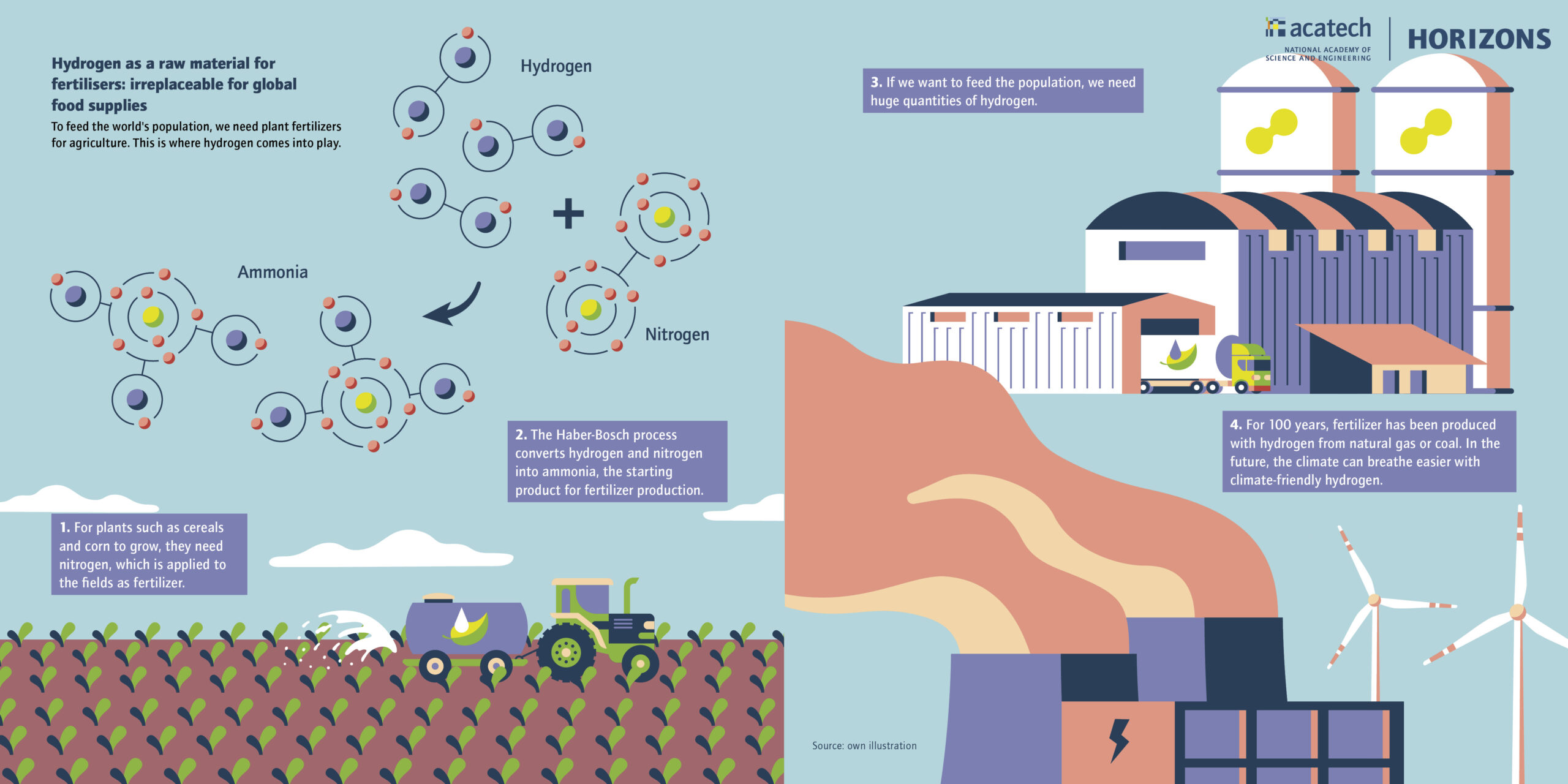
Climate-friendly mobility: hydrogen and electricity in tandem
Transport leaves a significant carbon footprint. Batteries in e-cars are one solution for emission-free driving but they have their limits: a ship or an aircraft would need such large and heavy batteries that they would not be able to travel very far at all. This is where hydrogen comes into play again because it can store electricity from renewables, with hydrogen being converted back into electricity in the car or aircraft. The exhaust fumes do not contain any climate-damaging gases but virtually only water. So, the debate is not between hydrogen or battery, we need both. Only this way can we make mobility sustainable and achieve climate targets.
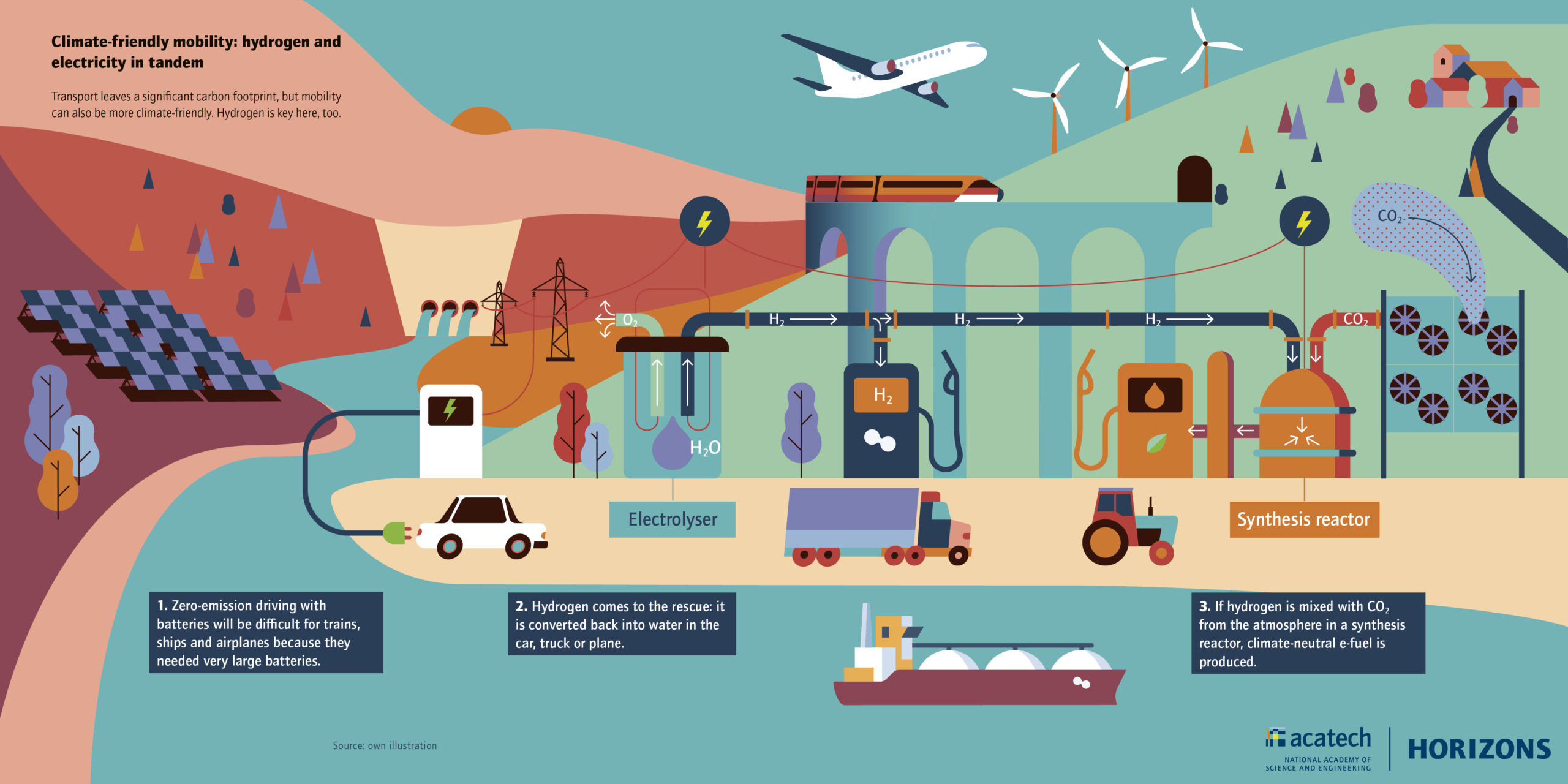
A socially just energy transition for all?

How can we combat climate change and shape the energy transition in a socially just way, i.e., such that living standards and opportunities are approximately equal for everyone in society? Ideally, everyone’s outlooks and differing requirements will be considered. Significant differences can arise along many dimensions, for example gender, ethnicity, age, religion, disability, or sexual orientation. In the context of climate change, energy, and hydrogen, for example, the EU Commission directly addresses the equality of women by taking the different life circumstances of men and women into account in its European Green Deal.
This is because women and men are not equally affected by climate change measures. For instance, women are at greater risk of falling into energy poverty. This is because women more often have difficulty paying the bills for their energy costs, such as electricity or gas, since they often still earn less than men. Rising energy prices due to the war in Ukraine (as of September 2022) and the shift to renewables, which are currently more expensive than fossil fuels, mean this gender gap is widening. It is right for policy makers to take proper account of these inequalities as we transition to a hydrogen economy.
But the gender gap in energy poverty is by no means the whole story because men still dominate the upper echelons of energy companies. Globally, men hold 94 per cent of ministerial posts with responsibility for national energy policy. In 2019, only four countries in the European Union had female energy ministers. It’s a good thing, that the EU already has this on its radar. It has developed a strategy for gender equality and backed it up with concrete measures which it intends to implement by 2025.
So, how and where from? The global perspective
For a while now, many countries have recognised the environmental and industrial potential of hydrogen. But where will the hydrogen come from and who will get it first until there is enough for everyone?
Only if all regions and countries join in and bring about a global reduction in the carbon footprint will we achieve the climate targets. For instance, in Europe and above all in Germany, we will have to import climate-friendly hydrogen from other regions, because we cannot produce enough ourselves. So, we are dependent on regions with plentiful sunlight, wind and open spaces such as Australia, Africa, South America or Southern Europe, to name just a few. However, we must be careful to ensure good and fair environmental and working conditions. If we get it right, in the coming years we will be able to export cutting-edge technology and knowhow from Europe and import climate-friendly hydrogen, while in the Global South more jobs and prosperity will be created. In comparison with fossil fuels, hydrogen also makes us less dependent on the few countries which have deposits of natural gas and oil.
How should we distribute the hydrogen? Where the greatest carbon savings are made or where the best price is paid? The question is, what will help the planet the fastest?
Martina Merz, CEO Thyssen Krupp AG
Then, what’s the problem, why isn’t everything already up and running? Although the world theoretically has unlimited supplies of wind and sunlight, we don’t yet have the hydrogen. First of all, we have to convert some parts of the global infrastructure and build other parts from the ground up in order to produce, store and transport hydrogen. For a while now, countries such as Australia, Japan, South Korea and China have recognised the enormous potential of hydrogen for the environment and industry and are making great strides forward. So, we should get going right now! We cannot yet answer the question of where hydrogen will come from and where it will go in the coming years. Cooperation with other regions is important but at the same time, we must ensure that everyone gets a fair slice of the hydrogen pie.
What needs to happen now?
What else can policy makers, business, academia and society do to make the quickest possible start with the hydrogen world? The final section provides some food for thought.
Markets and governments moving towards the hydrogen economy
A large proportion of hydrogen projects are migrating into regions where there are plentiful raw materials, open spaces, wind and sunlight, and these are mainly outside Europe. If Europe is not quick enough, it could in the worst-case scenario lose entire industries. It could be that the steel industry will completely migrate to a region where there is plentiful climate-friendly hydrogen as well as the raw material iron ore which is necessary for steel production.
The European industry is well aware of and Europe remains the technological leader in electrolysis, but we can only set up our own electrolysers to a limited extent: this is not only due to the limited areas of land for renewables and low availability of raw materials, but also due to a strict regulatory framework.
European policymakers have already taken some important steps to simplify the rules for green hydrogen so that European manufacturing companies can remain competitive. What’s important is for a significant proportion of value added to remain here and for European companies to continue to be leaders in technological know-how.
Behind the topic of hydrogen is the biggest business opportunity of the century – that’s as big as oil and gas were combined.
Prof. Dr. Robert Schlögl, Präsident Alexander von Humboldt-Foundation
Communicating Science
Scientists around the world are researching more efficient electrolysis technologies that produce climate-friendly hydrogen, the raw materials we need for electrolysers, and how we can store hydrogen efficiently and transport it safely. Science produces knowledge, creating the basis for innovation and technological progress. Though, it also has to share the knowledge it produces with other parts of society, i.e., with policymakers, industry and us citizens and present complex knowledge in a simple and understandable way, making it accessible to all. This is where science communication comes in. Only with support from a population which understands, accepts and trusts what is, after all, a new technology, does the energy transition have a chance at succeeding. Science, thus, contributes to democracy, with all people informed and jointly making decisions about our future founded on scientific knowledge.
Climate-neutral prosperity for society
We have the great fortune to live in a democracy: we always have access to information, can form our own opinion, go to the polls with this knowledge and decide for ourselves. Do we want to make the energy transition a reality, achieve climate targets, and live on a planet worth living on in the future? If so, the only way this is possible is for us to think globally and involve everyone. It is of little help to our planet if only some countries opt for climate-friendly hydrogen while in other countries oil and coal continue to be burned for industry and heating, or forests are cut down on a massive scale. Hydrogen is a huge opportunity to make the energy transition a reality, achieve climate targets, and distribute prosperity more fairly. It’s about giving something back to all of us – clean air to breathe, a healthy planet, more recreation, more time, a greater quality of life: a more climate-neutral prosperity.
Project group
- Philip Green
Australian Embassador to Germany - Nikolas Iwan
H2 MOBILITY Deutschland GmbH & Co. KG - Prof. Dr.-Ing. Karsten Lemmer
Member of the Executive Board DLR, Deutsches Zentrum für Luft- und Raumfahrt - Dr. Wiebke Lüke
Founder & Managing Director WEW GmbH, Water Electrolysis Work - Martina Merz
CEO Thyssen Krupp AG - Prof. Dr. Robert Schlögl (Leader of the project group)
President Alexander von Humboldt-Foundation - Prof. Dr. Christoph Schmidt
President RWI – Leibniz-Institute for Economic Research
Don’t want to miss any more HORIZONS editions? Register now with a short mail to horizonte@acatech.de or subscribe to our Newsletter TRANSFER.
HORIZONS is also on LinkedIn – follow us for “science in snacks”!







